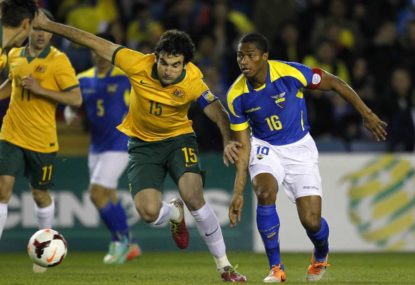Young excellence, promotion battles, and a happy farewell: The Australian team of the week from players around the globe
Even though St.Pauli ultimately lost a high-scoring affair, Jackson Irvine was a standout, as well as scoring a late goal.

Despite pre-tournament fears, the Socceroos have defied expectations and made the Asian Cup final thanks to an impressive campaign.
Besides the loss to South Korea, it has been a good campaign for our men so far as they’ve impressed throughout the tournament, with their results and style striking a chord with fans.
Ange Postecoglou had been the target of scorn for months beforehand but the style and pace of football played by the Socceroos vindicates his appointment and the route he has taken to mould an Asian Cup squad.
While it’s important they continue to play with style, the ultimate key to victory tonight lies in central midfield with Mile Jedinak.
The Socceroos captain and how he performs will be crucial to Australia’s chances of victory.
To understand this in context, we need to look at how he plays for Crystal Palace versus how he plays for Australia.
In the set up at Palace, Jedinak plays defensive midfield and has two major responsibilities.
He’s the clubs quarterback who when moving the ball out of defence, has the job of spreading the play by either pushing the ball wide and creating a triangle or knocking it long to allow the forwards to exploit the space with their speed.
Jedinak is also Palace’s problem solver, as whenever Palace encounters a lack of space or needs to play backwards, they give the ball to him and reset.
Importantly Jedinak has been reliable in this role because none of his managers at Sellhurst Park played someone similar to him, thus clarifying his job.
At this tournament it has been a different story.
Throughout the tournament, Ange has played with a 4-3-3 formation that expanded to a more conservative 4-1-4-1 during the knockout stages.
Postecoglou’s latter formation is underpinned by two strong yet cumbersome central defenders, attacking full backs and a three man centre midfield.
The roles Jedinak usually plays at a club level have been shared between him and a combination of Mark Bresciano, Massimo Luongo, Matt McKay and Mark Milligan.
As such, Jedinak is played in a covering role (aka ‘the wall’) with his job essentially to cover the lack of pace in the centre of defence.
It’s a role he is not particularly comfortable with playing and it has shown at times during the Asian Cup.
His performance against Kuwait prior to injury and his first 30 minutes in the clash with China exposed how out of place he was.
Unsure of whether to support midfield or sit back in support of his central defenders, Jedinak was getting caught out of place repeatedly and finding himself in no man’s land.
With Jedinak out of position, the space between midfield and defence opened up and this in turn exposed Spiranovic and Sainsbury’s and their lack of pace to the opposition.
In contrast, Jedinak’s performance in the same position against the UAE was a more polished effort.
Granted the UAE were poor the first hour of the semi, but Jedinak seemed to have come to terms with what is required of his position.
He occupied the space between midfield and defence stoically which helped protect his central defenders from being run over by the speedy Gulf side.
Importantly, he didn’t look confused nor did he try to do more than his position required of him, thus protecting the structure of the Socceroos midfield.
Considering the skill and pace of Jung-Hyup up forward and Tae-Hee through the middle, Jedinak’s number one priority must be to consistently protect his centre backs and resist the urge to push forward.
Tonight sees the biggest game in the history of Australian football take place in Sydney, with the Socceroos having on the cusp of Asian Cup glory.
Australia needs a big-time performance from its captain who’ll need to be on his guard against a tricky Korean side.